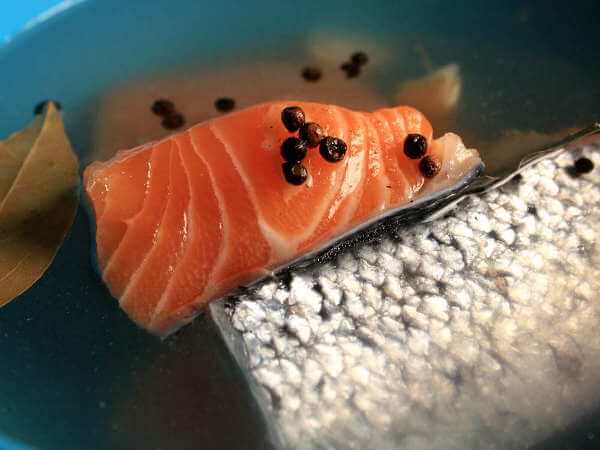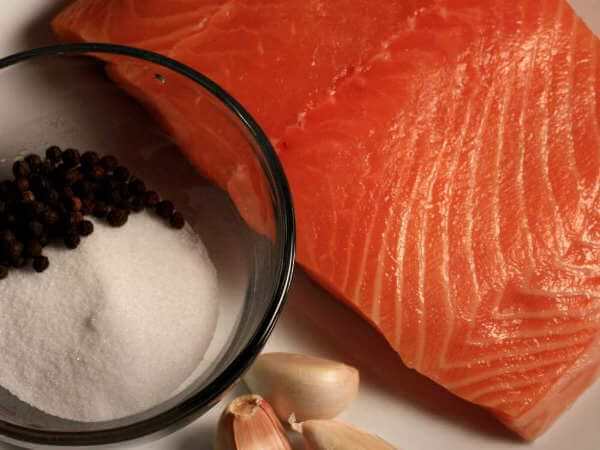Smoked Salmon Brining Tips and Techniques
These salmon brining tips and techniques cover various aspects of brining, and most importantly information that will insure that your smoked salmon is safe to eat.
You'll also learn procedures relating to food quality, which will enable you in your quest to make high quality, great tasting smoked salmon.

Salmon Brining Tips For Great Smoked Salmon
- Don't cross contaminate
- Don't reuse brine
- Don't decrease the amount of salt in the brine
- Do use pickling salt or kosher salt
- Do keep the brine cold
- Adjust brining time or rinse time to adjust salt taste
- Change the amount of sugar to adjust sweetness
Cleanliness Is Crucial
Cross contamination is easy to prevent as long as you remain aware of the things that have touched raw salmon.
Utensils, bowl and plates, towels, cutting boards, and table or countertop surfaces used when working with the raw salmon need to be cleaned before they come in contact with any cooked foods.
And that includes your hands. Wash them regularly. Using disposable gloves is a quick and easy way to keep your hands clean. Toss 'em and put on a new pair whenever you start a new chore.
Use Salmon Brine Once, and Only Once!
Get rid of that brine after it's been used...don't use it a second time. During the brining process, liquid and broken-down proteins are pulled from the flesh as salt, sugar, and flavors enter.
What remains has an unknown concentration of salt and sugar, and contains liquid and proteins removed from the salmon...not a very palatable mix.
Using fresh brine for each batch insures that you'll end up with high quality smoked salmon from batch to batch.
Tips for Making Salmon Brine
Salt and sugar dissolve in cold water, but not as well as in hot or boiling water. As water heats, the molecules move faster. And that movement causes the salt and sugar to dissolve more quickly.
If using spices or herbs in the brine, the flavors can be intensified by first giving them a quick simmer in a small amount of water. Doing this releases flavor that would otherwise be trapped in the seasonings.
Brine Saturation Level Is Critical
Three cups of salt in a gallon of water creates a solution of about 80% saturation. A solution of between 70% and 80% saturation is required to brine salmon properly.
This concentration will both cure and dehydrate the salmon to prepare it for smoking.
Choosing The Best Salt For The Smoked Salmon Brine
 Canning Salt, Peppercorns and Sockeye Fillet
Canning Salt, Peppercorns and Sockeye FilletThe type of salt used in brine will affect the taste of your salmon. Table salt can be iodized or non-iodized, and may also contain anti-clumping agents that keep it loose and free flowing.
Those ingredients can impart an undesirable flavor to the food. Never use iodized salt. It can add a metallic taste.
Pickling salt is finer than table salt, is non-iodized, and is ideal for brining. It doesn't contain anti-clumping agents, either. Kosher salt is non-iodized, and since it weighs less than table or pickling salt, it will take a greater volume.
Table salt weighs 10 ounces per cup, while Kosher weighs anywhere from 5 to 8 ounces per cup, depending on the brand. To convert, multiply the number of cups of salt called for in your recipe by ten, and weigh out that many ounces of Kosher salt.
Rock salt and ice cream salt are not pure...they contain various minerals that can affect the taste of your salmon, so they should not be used.
Chill The Brining Salmon To a Safe Temperature
Keeping the brining salmon cold is one of the most important brining tips. Don't take a chance on allowing bacterial growth. Brining fish and meat must be kept at between 35 and 40 degrees Fahrenheit.
If there's room in the fridge, great. If not, use a cooler. Bag the brining salmon in good, leak proof freezer bags and put them in a large pan or bowl in the fridge. Or put the bagged, brining salmon into a cooler, along with some ice.
Adjusting Salt and Sweet Taste Perception Of Your Smoked Salmon
To adjust the saltiness of your salmon, decrease or increase the brining time. A longer brining tips the balance toward a saltier taste. Rinsing longer will pull salt out of the salmon.
Keep records of how long you brine and rinse and use the information to make adjustments with your next batch. To increase or decrease the sweetness of the salmon, change the amount of sugar you add to the brine.
With these tips you'll be able to produce great tasting, safe-to-eat smoked salmon.
- You Are Here: Home >
- Tips >
- Brining Tips

